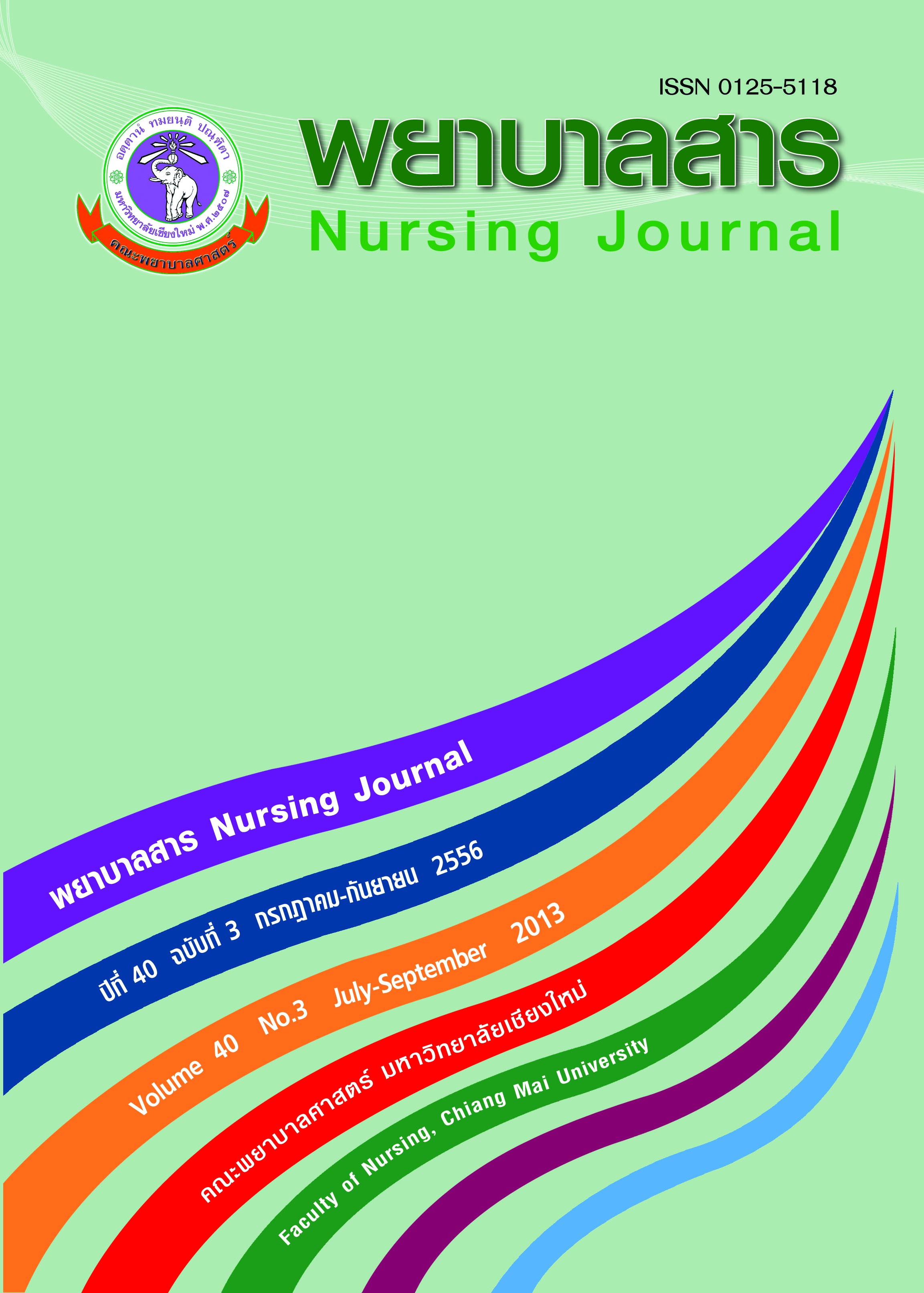การปฏิบัติการวางแผนจำหน่ายทารกเกิดก่อนกำหนด ในหอผู้ป่วยหนักทารกแรกเกิด โรงพยาบาลศูนย์แห่งหนึ่งในภาคเหนือ
Keywords:
การวางแผนจำหน่าย, การวางแผนจำหน่ายทารกเกิดก่อนกำหนด, ทารกเกิดก่อนกำหนด, Discharge Planning, Preterm Infants, Going Home, Discharge Planning of Preterm InfantsAbstract
บทคัดย่อ
การปฏิบัติการวางแผนจำหน่ายเป็นการปฏิบัติการพยาบาลเพื่อดูแลผู้ป่วยอย่างต่อเนื่องเพื่อให้เกิดผลลัพธ์ที่ดีต่อผู้ป่วยและครอบครัว การศึกษาวิจัยเชิงพรรณนาครั้งนี้มีวัตถุประสงค์เพื่อศึกษาการปฏิบัติการวางแผนจำหน่ายทารกเกิดก่อนกำหนดของพยาบาลวิชาชีพ ปัจจัยที่เกี่ยวข้องกับการวางแผนจำหน่ายทารกเกิดก่อนกำหนดผลลัพธ์ของการวางแผนจำหน่ายทารกเกิดก่อนกำหนด ในหอผู้ป่วยหนักทารกแรกเกิด โรงพยาบาลศูนย์แห่งหนึ่งในภาคเหนือ กลุ่มตัวอย่างประกอบด้วย พยาบาลวิชาชีพที่ปฏิบัติงานในหอผู้ป่วยหนักทารกแรกเกิด โรงพยาบาลศูนย์แห่งหนึ่งในภาคเหนือ ทารกเกิดก่อนอายุครรภ์ 37 สัปดาห์ มีนํ้าหนักแรกเกิดน้อยกว่า 2,500 กรัม ที่ได้รับการจำหน่ายออกจากหอผู้ป่วยหนักทารกแรกเกิดในระหว่างเดือนมีนาคมถึงเดือนเมษายน พ.ศ. 2552 และมารดาของทารกเกิดก่อนกำหนดที่เป็นกลุ่มตัวอย่างสามารถสื่อสารภาษาไทยเข้าใจ เครื่องมือที่ใช้รวบรวมข้อมูลประกอบด้วย1) แบบสอบถามข้อมูลทั่วไปของพยาบาลวิชาชีพ 2) แบบสอบถามการปฏิบัติการวางแผนจำหน่ายทารกเกิดก่อนกำหนด 3) แบบสอบถามปัจจัยที่เกี่ยวข้องกับการวางแผนจำหน่ายทารกเกิดก่อนกำหนด 4) แบบสอบถามข้อมูลทั่วไปของมารดา และทารก และค่าใช้จ่าย ระยะวันนอนในโรงพยาบาล 5) แบบสอบถามความรู้ของมารดาในการดูแลทารกเกิดก่อนกำหนด แบบสอบถามดังกล่าวผู้วิจัยสร้างขึ้นจากการทบทวนวรรณกรรมเพื่อใช้ประเมินการปฏิบัติ ปัจจัย และผลลัพธ์ที่เกี่ยวข้องในการวางแผนจำหน่ายแบบสอบถามทั้งหมดผ่านการตรวจสอบความเที่ยงตรงและความเชื่อมั่น วิเคราะห์ข้อมูลโดยใช้โปรแกรมคอมพิวเตอร์สำเร็จรูปด้วยสถิติพรรณนา ได้แก่ จำนวน ร้อยละพิสัย ค่าเฉลี่ย และส่วนเบี่ยงเบนมาตรฐาน
ผลการวิจัย พบว่า
1. การปฏิบัติการวางแผนจำหน่ายทารกเกิดก่อนกำหนดของพยาบาลวิชาชีพพบว่าร้อยละร้อย ปฏิบัติทุกครั้งในการประเมินปัญหาจากการสังเกตและตรวจร่างกายทารกเกิดก่อนกำหนด การให้กำลังใจ การส่งเสริมให้ครอบครัวมีส่วนร่วมในการวางแผนจำหน่าย การสอน สนทนาซักถามให้มารดาเกิดความรู้ในการดูแลทารกเกิดก่อนกำหนด รวมทั้งการกำหนดวันนัดตามแผนการรักษาของแพทย์และแจ้งให้มารดาทราบ และพบว่าร้อยละ 61.53ไม่มีคู่มือหรือเอกสารในการดูแลทารกเกิดก่อนกำหนดให้แก่มารดาและหรือครอบครัว
2. ปัจจัยที่เกี่ยวข้องกับการวางแผนจำหน่ายทารกเกิดก่อนกำหนด ในด้านการมีส่วนร่วมของทีมสุขภาพและผู้ใช้บริการ พบว่าพยาบาลวิชาชีพ ร้อยละ 69.23 เห็นว่าในองค์กรพยาบาลวิชาชีพให้ความร่วมมือในการกำหนดกิจกรรมการดูแลทารกเกิดก่อนกำหนด แต่ทีมสุขภาพอื่นๆ มีความร่วมมือในการกำหนดกิจกรรมการดูแลทารกเกิดก่อนกำหนดเป็นส่วนน้อย และพยาบาลวิชาชีพ ร้อยละ 53.84 เห็นว่าครอบครัวทารกเกิดก่อนกำหนดมีส่วนร่วมในการวางแผนการจำหน่าย
3. ผลลัพธ์ที่เกี่ยวข้องกับการวางแผนจำหน่าย พบว่าทารกเกิดก่อนกำหนดทุกรายมีการจำหน่ายออกจากหอผู้ป่วยหนักทารกแรกเกิดไปยังหอผู้ป่วยกุมารเวชกรรม ทารกเกิดก่อนกำหนด ร้อยละ 64.70 มีจำนวนวันนอนน้อยกว่าหรือเท่ากับ 40 วัน (Xˉ = 32.35, S.D. = 31.25) และร้อยละ 58.82 มีค่าใช้จ่ายขณะรับการรักษาในโรงพยาบาลน้อยกว่าหรือเท่ากับ 100,000 บาท (Xˉ =164,190.65, S.D.= 181,305.30) พิจารณาค่าใช้จ่ายจำแนกตามรายการร้อยละ 39 เป็นค่าใช้จ่ายรวมของค่าอุปกรณ์ของใช้และเครื่องมือทางการแพทย ์ และพบว่าร้อยละ 82.35 ของมารดาทารกเกิดก่อนกำหนดมีคะแนนความรู้ในการดูแลทารกเกิดก่อนกำหนดอยู่ในระดับมาก
ผลการศึกษาครั้งนี้สามารถใช้เป็นข้อมูลพื้นฐานและเป็นแนวทางในการปรับปรุงพัฒนาการปฏิบัติการวางแผนจำหน่ายทารกเกิดก่อนกำหนด ซึ่งผู้บริหารทางการพยาบาลสามารถนำผลการศึกษาครั้งนี้ไปใช้ในการพัฒนา การวางแผนจำหน่ายทารกเกิดก่อนกำหนดต่อไป
คำสำคัญ: การวางแผนจำหน่าย การวางแผนจำหน่ายทารกเกิดก่อนกำหนด ทารกเกิดก่อนกำหนด
Abstract
Discharge planning is a nursing task that involves taking care of the patient continuouslyafter they leave the hospital, to provide good outcomes to patients and their families. The objectivesof this descriptive study were to study the practice of discharge planning by professional nurses,factors related to discharge planning, and the practice outcomes for premature newborn infants inthe neonatal intensive care unit at one of Tertiary Hospitals, Northern Region. The subjects wereprofessional nurses who worked in the neonatal intensive care unit at one of Tertiary Hospitals,Northern Region and took care of infants born before 37 weeks gestational age; weighed less than2,500 grams, and with birth mothers who were able to communicate in Thai. The infants weredischarged from the neonatal intensive care unit between March and April 2009. Tools used tocollect data were comprised of: 1) general questionnaire for professional nurses; 2) questionnaireof discharge planning practices; 3) factors related to the discharge planning practices; 4) generalquestionnaire for the mother and the infant, expenses, and duration of hospital stay; and 5)questionnaire for assessment of knowledge of the mother in the infant care. All questionnaireswere developed based on a review of the literature and tested for validity and reliability. Descriptivestatistics were and included amount, percentage, range, mean and standard deviation.
The results of study
1. For discharge planning practices of professional nurses, all nurses (100%) conductedthe following practices every time: diagnosing problems and physical assessment of the prematurenewborn infants, supporting the participation of the family in discharge planning, educating knowledgeof premature newborn infant care to the mothers and determination of follow up. Most nurses (61.53%) did not provide the mother and/or family a handbook or documents regarding infant care.
2. For factors related to the discharge planning practices; most nurses (69.23%) felt thatthe organization supported nurses in conducting activities related to premature newborn infant carebut other members of the healthcare team had little participation in those activities. Most family ofpremature newborn infants (53.84%) participated in discharge planning.
3. For discharge planning outcomes, the results revealed that all premature newborn infantswere discharged from neonatal intensive care unit to nursery unit. Most premature newborn infants(64.70%) had a hospital stay less than or equal to 40 days (Xˉ = 32.35, S.D. = 31.25), and mostpremature newborn infants (58.82%) had hospital expenses less than or equal to 100,000 baht.(Xˉ =164,190.65, S.D. = 181,305.30), of which expenses related to equipment and medical devicesaccounted for 39%. Furthermore, most mothers (82.35%) had knowledge in premature newborninfant care at a high-level.
In conclusion, the results from this study provide preliminary information of discharge planningpractices, and could be used as guidance for nurses to develop and improve discharge planningpractices for premature newborn infants.
Key words: Discharge Planning, Preterm Infants, Going Home, Discharge Planning ofPreterm Infants
Downloads
How to Cite
Issue
Section
License
บทความที่ได้รับการตีพิมพ์เป็นลิขสิทธิ์ของวารสารพยาบาลสาร
ข้อความที่ปรากฏในบทความแต่ละเรื่องในวารสารวิชาการเล่มนี้เป็นความคิดเห็นส่วนตัวของผู้เขียนแต่ละท่านไม่เกี่ยวข้องกับมหาวิทยาลัยเชียงใหม่ และคณาจารย์ท่านอื่นๆในมหาวิทยาลัยฯ แต่อย่างใด ความรับผิดชอบองค์ประกอบทั้งหมดของบทความแต่ละเรื่องเป็นของผู้เขียนแต่ละท่าน หากมีความผิดพลาดใด ๆ ผู้เขียนแต่ละท่านจะรับผิดชอบบทความของตนเองแต่ผู้เดียว






